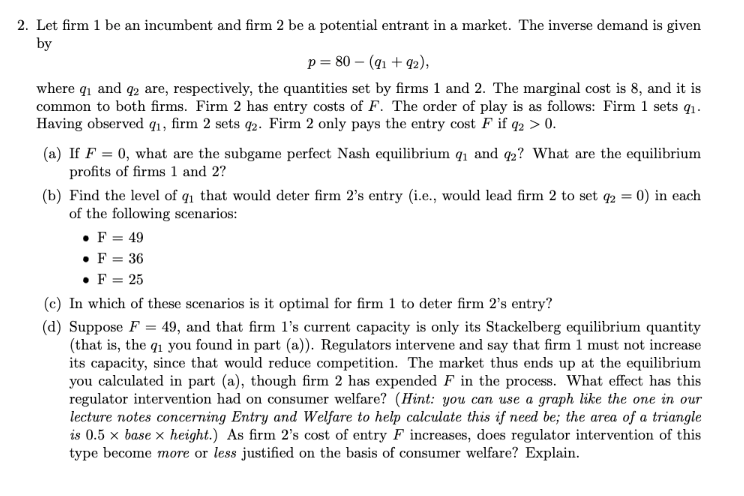Answered step by step
Verified Expert Solution
Question
1 Approved Answer
2. Let firm 1 be an incumbent and firm 2 be a potential entrant in a market. The inverse demand is given by p

2. Let firm 1 be an incumbent and firm 2 be a potential entrant in a market. The inverse demand is given by p = 80 - (91 + 92), where q and q2 are, respectively, the quantities set by firms 1 and 2. The marginal cost is 8, and it is common to both firms. Firm 2 has entry costs of F. The order of play is as follows: Firm 1 sets q. Having observed q, firm 2 sets 92. Firm 2 only pays the entry cost F if q2 > 0. (a) If F = 0, what are the subgame perfect Nash equilibrium q and 92? What are the equilibrium profits of firms 1 and 2? (b) Find the level of q that would deter firm 2's entry (i.e., would lead firm 2 to set q2 = 0) in each of the following scenarios: F = 49 F = 36 F = 25 (c) In which of these scenarios is it optimal for firm 1 to deter firm 2's entry? (d) Suppose F49, and that firm 1's current capacity is only its Stackelberg equilibrium quantity (that is, the q you found in part (a)). Regulators intervene and say that firm 1 must not increase its capacity, since that would reduce competition. The market thus ends up at the equilibrium you calculated in part (a), though firm 2 has expended F in the process. What effect has this regulator intervention had on consumer welfare? (Hint: you can use a graph like the one in our lecture notes concerning Entry and Welfare to help calculate this if need be; the area of a triangle is 0.5 x base x height.) As firm 2's cost of entry F increases, does regulator intervention of this type become more or less justified on the basis of consumer welfare? Explain.
Step by Step Solution
There are 3 Steps involved in it
Step: 1

Get Instant Access to Expert-Tailored Solutions
See step-by-step solutions with expert insights and AI powered tools for academic success
Step: 2

Step: 3

Ace Your Homework with AI
Get the answers you need in no time with our AI-driven, step-by-step assistance
Get Started


